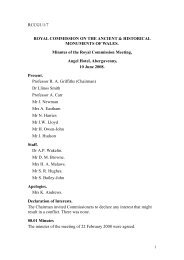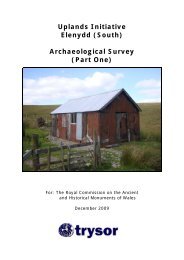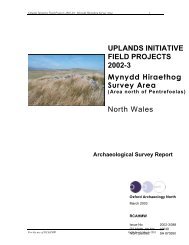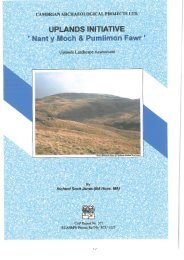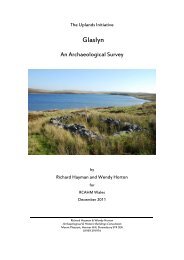Beacon Hill, Radnorshire - Royal Commission on the Ancient and ...
Beacon Hill, Radnorshire - Royal Commission on the Ancient and ...
Beacon Hill, Radnorshire - Royal Commission on the Ancient and ...
You also want an ePaper? Increase the reach of your titles
YUMPU automatically turns print PDFs into web optimized ePapers that Google loves.
RCAHM Wales Upl<strong>and</strong>s Initiative – <str<strong>on</strong>g>Beac<strong>on</strong></str<strong>on</strong>g> <str<strong>on</strong>g>Hill</str<strong>on</strong>g>Early MedievalThe o<strong>the</strong>r m<strong>on</strong>umental feature of <strong>the</strong> <str<strong>on</strong>g>Beac<strong>on</strong></str<strong>on</strong>g> <str<strong>on</strong>g>Hill</str<strong>on</strong>g> l<strong>and</strong>scape is Short Ditch (nprn306151, figure 4). Short Ditch is a cross-ridge dyke 640m l<strong>on</strong>g, with a bank <strong>on</strong> <strong>the</strong>western side. It joins a deep stream valley at <strong>the</strong> north-east end, which effectivelyc<strong>on</strong>tinues <strong>the</strong> boundary. The c<strong>on</strong>juncti<strong>on</strong> of artificial <strong>and</strong> natural barriers is a featurenoted at o<strong>the</strong>r short dykes. Investigati<strong>on</strong> of this site was included in <strong>the</strong> Short DykesProject undertaken by CPAT (Hankins<strong>on</strong> 2004), following which augers were takenthat yielded organic layers beneath <strong>the</strong> earthwork. An organic layer, possibly turfstripped from <strong>the</strong> line of <strong>the</strong> ditch <strong>and</strong> laid <strong>on</strong> <strong>the</strong> old ground surface, has given acalibrated radiocarb<strong>on</strong> date in <strong>the</strong> range AD 410-590.Short Dykes were <strong>on</strong>ce interpreted as defensive structures but this <strong>the</strong>ory has fallenout of favour. The defensive limitati<strong>on</strong>s of such a short earthwork have beenrecognised. A more likely interpretati<strong>on</strong> is that it was built to verify or claim aboundary, at a time when it was customary to use natural or topographical features todefine boundaries. It has been suggested that following <strong>the</strong> collapse of Romanadministrati<strong>on</strong> in <strong>the</strong> early fifth century Short Ditch was an attempt to define <strong>the</strong>boundary of an administrative unit (Hankins<strong>on</strong> <strong>and</strong> Caseldine 2006, 266-68). Itspositi<strong>on</strong> <strong>on</strong> <str<strong>on</strong>g>Beac<strong>on</strong></str<strong>on</strong>g> <str<strong>on</strong>g>Hill</str<strong>on</strong>g> dem<strong>on</strong>strates that <strong>the</strong> Teme valley immediately to <strong>the</strong> eastwas incorporated into a single administrative unit. Later in <strong>the</strong> Middle Ages <strong>the</strong>border between Engl<strong>and</strong> <strong>the</strong> March followed <strong>the</strong> river Teme, <strong>the</strong>reby dividing <strong>the</strong>Teme valley into separate jurisdicti<strong>on</strong>s.Figure 4. Short Ditch (nprn 306151), looking south west, showing modern damage in<strong>the</strong> foreground.Medieval <strong>and</strong> post-medieval settlement <strong>and</strong> agricultureEvidence of medieval <strong>and</strong> post-medieval settlement <strong>and</strong> agriculture was found inabundance. In broad terms <strong>the</strong> evidence c<strong>on</strong>forms to <strong>the</strong> overview of medieval <strong>and</strong>post-medieval settlement in <str<strong>on</strong>g>Radnorshire</str<strong>on</strong>g> described by previous work (Silvester 2004,6



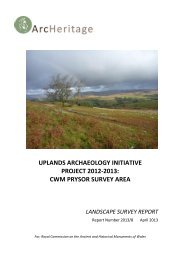
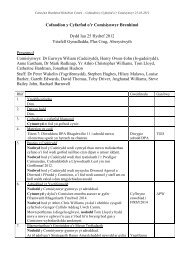
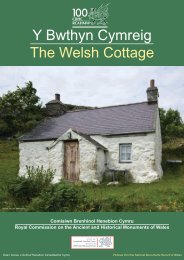

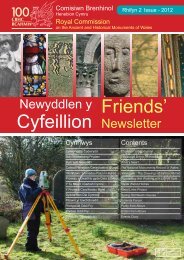
![The Source of the Usk Walk [2012 PDF]](https://img.yumpu.com/49285699/1/190x245/the-source-of-the-usk-walk-2012-pdf.jpg?quality=85)


